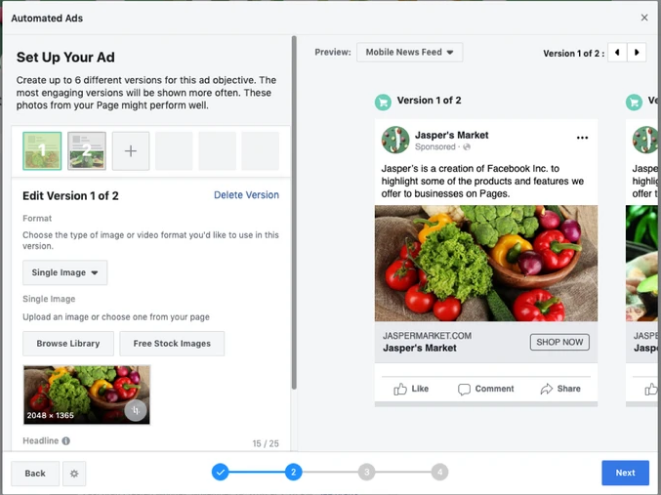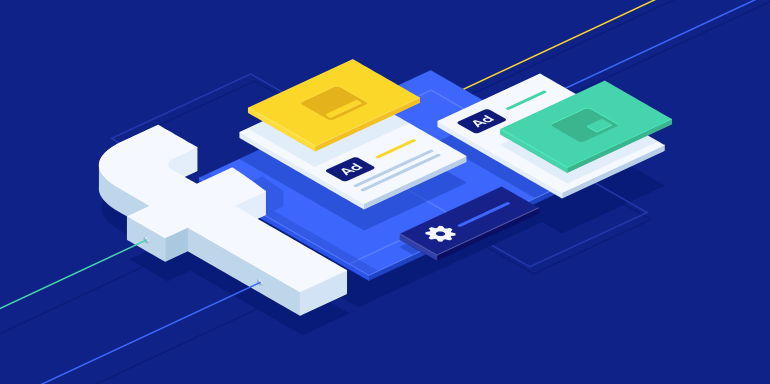Advertising automation helps advertisers seamlessly create ad campaigns that are successful at engaging their audience, leading to an increase in advertising conversions and eventually, business growth.
Facebook Ads’ automation capabilities are no different.
Today’s post will discuss everything you can do to automate your Facebook advertising campaigns. We’ll begin by defining Facebook Automated Ads and then outline other automation capabilities, such as boosted posts, automated rules, automatic bidding, and dynamic product ads.
What are Facebook Automated Ads?
Automated Ads take the guesswork out of your Facebook ads; all campaign owners must do is answer a few questions about their company and their campaign goals. The ad network takes care of the rest.
Automated ads were essentially created for small business owners, according to Facebook’s Director of Product Management Nikila Srinivasan:
The feature was really built for small businesses that are one- to two-person businesses with very little marketing expertise.
However, every advertiser can use automated ads to speed up their social media ads.
The feature provides a custom advertising plan with step-by-step recommendations for the right ads you should run. Over time, automated ads learn what performs best and will make improvements and suggestions for your campaigns:

Like Google Ads Automation capabilities, Facebook Automated Ads also help you accomplish multiple business goals like getting people to visit your website or generating more leads. After you’ve identified your goal, the ad feature will help create and manage the ads in the following ways:
- Multiple versions of your ad: Create up to 6 different versions of your ad, you’ll get suggestions for CTA buttons, text, and other creative details based on information from your company Page. After the ad is active for some time, Facebook will automatically start showing the best-performing version of the ad.
- Tailored audience suggestions: Get audience options based on information from your Page, automated ads also give you automatic audience options that are customized to your business. Facebook creates and improves your automatic audience from a combination of details, like people near your business location or people who have interests related to your Page.
- Recommended budget that generates results: Automated Ads will also recommend a budget most likely to get results based on the goal set. Conversely, you can also provide the budget and Facebook will share the expected estimated results.
- Timely notifications about your ads: You’ll receive notifications to help understand how the ads are performing and ways to improve them. The suggestions may include changes such as updating an image or notifying you when an ad starts generating results like a lead or a sale.
Availability
As of this article’s publishing (September 2019), Automated Ads are gradually rolling out and only available on desktop. Setting up the feature for your ad campaigns is easy, just follow the steps highlighted in this Facebook post.
Automated Ads run continuously to learn what performs better for your plan, you won’t be able to set an end date, but you can pause or delete the feature at any time.
Facebook also provides automation capabilities to advertisers with boosted posts, so let’s see what makes both ad options different from each other.
Automated Ads vs boosted posts
A boosted post lives on your timeline that you can apply budget towards to increase its reach to an audience of your choosing. Boosting a post makes it show up in your audience’s Facebook News Feed as an ad. You don’t have to go to the Ads Manager to create a boosted post, plus you can also select Instagram as an ad placement for the boosted post.
With boosted posts, you can set optimizations for certain actions like website visits. However, the primary objective for the ad type has always been to increase post engagement. Simply choose a post that’s already live on your Page’s timeline and boost it by following only a few steps. When you boost a post, you tell Facebook the following:
- Who you want to reach: Pick a target audience or select the type of people you want to connect with
- The maximum budget: Tell Facebook exactly how much you want to spend over the course of the entire campaign
- How long you want to run an ad: After clicking “Boost” the ad is approved, and people in your target audience will start seeing the ad in their News Feed for the duration you’ve set.
Boosted posts help maximize ad visibility and eventually grow your audience. However, the biggest disadvantage of relying on boosted posts is the lack of control you have.
Limitations of boosted posts
You can’t see who you’ve reached — just the number of people you have reached, so this doesn’t give you a clear picture of your engaged audience. You also can’t target your campaigns toward different actions, like raising awareness or selling a product. Plus, you can’t take your audience and compare it to another with different interests to determine which group connects best with your post.
The key difference between Automated Ads and boosted posts is that the latter are fully geared towards finding people who are likely to take the action you want them to on the ad, and they’re designed to run for a longer period so they have a better opportunity to optimize and improve over time.
For an ad campaign meant to increase advertising conversions, automated ads are your best chance for success.
What are Facebook automated rules?
Facebook Automated Rules allow advertisers to forgo continuous optimization and monitoring tasks. The rules automatically check your campaigns, ad sets, and ads for the rules you identify, and then update or notify you of any changes. Along with the automatic checks and notifications, the tool also takes necessary actions for you.
When you create an automated rule, you choose:
- The criteria that triggers the rule
- The action your rule takes on the ad
- The active campaign, ad set, or ad you want the rule to affect
Automated rules assist you in managing multiple ads you’re running at the same time. Think about the items you frequently check up on and the subsequent actions you take in Ads Manager.
For example, do you frequently perform the following actions?
- Pause a low-performing ad when it hits a specific metric
- Turn on campaigns/ad sets/ads when certain criteria is reached
- Increase your budget when a certain number of users who click an ad in a given ad set
- Increase the bid if the total daily spend is below a certain amount
- Increase budget based on return on ad spend (ROAS)
- Turn off a specific ad set campaign on a specific day
You can create an automated rule for all situations above, after choosing an action for your rule, then select the conditions that trigger the rule.
Types of automation within Facebook ad campaigns
Other types of automation available include:
- Performance Alerts: Get an email alert with a list of the affected campaigns, ad sets, or ad creative that are experiencing positive or negative performance trends. These trends could be high/low CTRs, budget spend, or Cost Per Conversion.
- ROAS ad rules: Automated rules also help you control your ad spend. You have the option to set up rules to stop ad sets that fall below your minimum ROAS and to turn off ad sets when spend is more than twice the cost per purchase.
- Ad Set Scheduling: Ad performance can vary on different days of the week and during different hours in a day. Choose to show ads in peak performance hours as opposed to running evergreen ad sets as this keeps your cost per conversion trends low.
- Optimization Rules: Choose the conditions when you would like technology to make optimizations on your behalf. For example, you can create a rule that goes through all your active ad creative within a campaign and pauses ads with high cost per conversion trends.
- Ad Creative Testing: This includes multivariate testing, ad flighting, and ad rotation rules. Multivariate testing lets you test different headlines, description copy, images, CTAs, and destination links. Ad flighting/sequencing helps you group, align, and schedule clusters of ads that are triggered based on performance or time duration. Whereas, ad rotation rules rotate multiple ad creatives based on performance or time duration, without a specific order.
Facebook Automated Rules allow marketers to automate the customization of their ad campaigns, so they have to put in less effort while enjoying higher rewards.
In addition to Automated Ads, boosted posts, and Automated Rules, you can also automate your Facebook campaigns by:
- Automatic bidding: After you’ve selected a delivery optimization method, you’ll have to choose between automatic and manual bidding. If you’re unsure which bids to use, you can let Facebook set the bid to help you get the most link clicks at the best price.
- Dynamic product ads: The ads use a basic template to distribute ads containing different products and their information (price, image, details) to the right audience. When you retarget people with dynamic ads, people automatically see the products (or similar products) they saw on your website, post-click page, or in your app. You can use multiple ad formats for dynamic ads, such as single image ads, Carousel Ads, or Collection Ads.
Use Facebook Automated Rules and other automation capabilities offered by the ad network to maximize the potential of your campaigns.
Facebook Ads’ automation eliminates the guesswork
Within Facebook Ads Manager, you get access to multiple features that help you create highly targeted campaigns and deliver results. However, the Facebook algorithm is pretty complex, which means when you experiment with ads to find the best performing one, you will likely have a few setbacks.
Automation changes that.
Facebook Ads automation uses machine learning to adapt to individual user interests, helps identify the ad with the potential to drive maximum engagement and advertising conversions, thus taking the burden away from advertisers.
See how Instapage automates conversions with a personalized demo here.

See the Instapage Enterprise Plan in Action.
Demo includes AdMap™, Personalization, AMP,
Global Blocks, heatmaps & more.
